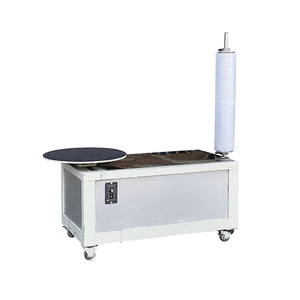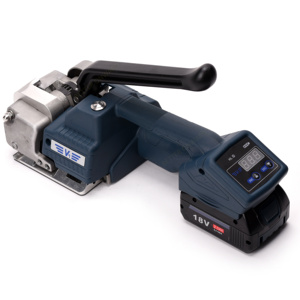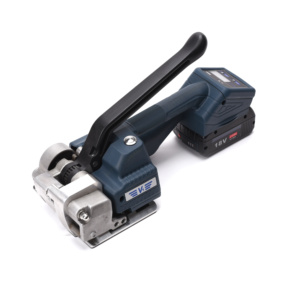
All categories
Featured selections
Trade Assurance
Buyer Central
Help Center
Get the app
Become a supplier

(3281 products available)




















Packaging heavy or large items like pallets, especially for export or intercontinental transport, requires the use of a strong but lightweight banding material and an efficient way to apply it. The pallet strapping tool is used to apply tension to the strap before securing it with any of the various types of pallet strapping seals. Strapping tools vary in design by the method of sealing the strapping.
Manual pallet strapping tools come in two varieties: sealless and seal strapping tools. The sealless is more common because it uses an integral applied to the strapping to secure it once the tension is applied. This eliminates the need for separate metal or plastic seals, reducing packaging costs. The sealless application is also more efficient, further decreasing costs.
Both methods require a separate strapping seal to be applied at the junction of the strapping. Manual strapping tools also include strapping installers and combination tools, which are usually more affordable but less effective than powered tools.
Powered strapping tools can be pneumatic or electric. They are more efficient than manual tools and are preferable when there are many pallets to strap or when better safety and increased suture strength are needed. Pneumatic strapping tools use compressed air to tension the strapping, and the sealing is done with a separate cradle and weld setup. On the other hand, electric strapping tools have a motorized mechanism that provides tension to the strapping. The strapping is then secured using a friction lock.
Automatic strapping machines are used when the strapping is to be done at an integrated packing line and are the most efficient way to strap pallets. An entry-level model will have the pallet placed manually in the machine before it is strapped automatically. Some entry-level models will have to be strapped manually and electrically (as in a combination). In higher-end models, a fully automated machine will have all manual work eliminated, and the strapping will be done with a conveyor feeder system.
Generally, the strapping material will be plastic or steel.
Some of the key specifications of the strapper are as follows:
For tools and machines, maintenance is always necessary to keep them in good shape. Luckily, pallet strapping tools are easy to maintain. Usually, it is recommended to clean the tool regularly and remove any debris, dust, and strap remnants. This ensures it is operating smoothly at all times. Additionally, one should lubric the moving parts of the tool, such as hinges, slides, and bearings, with a lithium grease or any other multipurpose lubricant. Strapping tools used on heavy-duty items can experience wear and tear fast. Manufacturers advise users to inspect the tools regularly for damages and identify any abnormalities that may arise when using them. This helps to prolong their lifespan, and any damages can be worked on immediately.
Many industries manufacture products, the last step of which is to pack everything onto a pallet. These are typically strapped with steel strapping tools for pallets. Here are some common usage scenarios for pallet strapping tools:
Strapping tools are used to secure goods and items that may move during transportation. Choosing the suitable strapping equipment can improve the packaging process by increasing production and inventory levels.
Types of Strapping:
Two primary categories are used with strapping tools: plastic and steel strapping. Plastic strapping is lighter, more corrosion-resistant, and a better value than steel. However, steel strapping is more robust, is ideal for securing heavy objects, and can withstand rough handling. It is imperative first to determine what type of strapping is used and whether the strapping tool will be compatible with the strapping.
Packing Tension:
Different strapping tools apply varying degrees of tension to the strapping, which can impact the level of securement provided. Some tools are designed to apply high tension, which is especially important when bundling or pallet strapping tools where goods may move and need to stay in place. Others are designed for lighter tension, which may be more appropriate for less critical securement applications. When selecting a tool, the packing tension required for the specific application should be considered.
Strapping Tool Weight:
The weight of the strapping tool can impact its usability and efficiency in the packaging process. Heavier tools may provide more durable construction and secure strapping but can lead to increased fatigue during extended use. Lighter tools may offer improved maneuverability and reduced fatigue but must be adequately robust to do the job. The tool's weight should be considered in light of the packaging operation's efficiency, productivity, and employee comfort.
Powered vs. Manual Strapping Tools:
Strapping tools are typically categorized as manual or powered. While manual tools are more prevalent and affordable, powered tools increase productivity and efficiency. Pneumatic strapping tools are among the powered options and require a compressed air source. Consider the packaging process's production needs, employee comfort, and demand. Consider whether the compression air source will be available for use.
Q1: What materials does a pallet strapping tool work with?
A1: Strapping tools are designed to work with specific strapping materials. Some may work with polyester, and others with polypropylene. Always check the device's specifications to know what material it works with.
Q2: Can the pallet strapping tools be used with any size of strapping?
A2: No, strapping tools are manufactured to work with certain strap sizes. Using it with a different size can affect the performance, damage the tool, or cause ineffective strapping.
Q3: Are pallet strapping tools dangerous?
A3: Strapping tools do pose some dangers. Manual strapping tools can snap back if the operator overstretches the strap. Electric strapping tools have moving parts that can cause pinching hazards.
Q4: Can one use a pallet strapping tool on products with irregular shapes?
A4: Yes. Strapping tools can strap products with irregular shapes as long as the pallet strapping tool is big enough. Stretching the strap until it fits the product is important. However, be careful not to overstretch and damage the product.